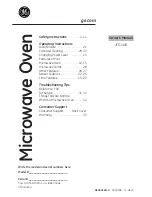
EN
EN – 18
EN – 18
Food Characteristics
Composition
Foods high in fat or sugar (e.g. Christmas pudding, mince pies) require less heating time.
Care should be taken as overheating can lead to fi re.
Bones in food conduct heat, making the food cook more quickly. Care must be taken so
that the food is cooked evenly.
Density
Food density will aff ect the amount of cooking time needed.
Light porous foods, such as cakes or bread, cook more quickly than heavy, dense foods,
such as roasts and casseroles.
Quantity
The number of microwaves in your oven remains the same regardless of how much food
is being cooked. The cooking time must be increased as the amount of food placed in
the oven increases.
e.g. Four potatoes will take longer to cook than two.
Size
Small foods and small pieces cook faster than large ones, as microwaves can penetrate
from all sides to the centre. For even cooking make all the pieces the same size.
Shape
Foods which are irregular in shape, such as chicken breasts or drumsticks, take longer to
cook in the thicker parts. For even cooking, place the thickest parts to the outside of the
dish where they will receive more energy.
Round shapes cook more evenly than square shapes when microwave cooking.
Temperature of food
The initial temperature of food aff ects the amount of cooking time needed.
Chilled foods will take longer to cook than food at room temperature.
The temperature of the container is not a true indication of the temperature of the food
or drink. Cut into foods with fi llings, for example jam doughnuts, to release heat or
steam.
WARNING: Face & Hands: Always use oven gloves to remove food or cookware from the oven. Stand
back when opening the oven door to allow heat or steam to disperse. When removing
covers (such as cling fi lm), opening roasting bags or popcorn packaging, direct steam away
from face and hands.
WARNING: Check the temperature of food and drink, stir before serving. Take special care when
serving to babies, children or the elderly. The contents of feeding bottles and baby food
jars are to be stirred or shaken and the temperature is to be checked before consumption
to avoid burns.
EN – 19
EN – 19
DEFROSTING ADVICE
Using your microwave oven is the quickest defrosting method. It is a simple process but the following instructions are
essential to ensure the food is thoroughly defrosted.
• Remove all packaging and wrapping before defrosting.
• To defrost food, use microwave level , or Defrost
• Please refer to the further information below.
Rearrange
Foods that are placed towards the outside of the dish will defrost quicker than foods in the centre. It is therefore
essential that the food is rearranged up to 4 times during defrosting.
Move closely packed pieces from the outside to the centre and rearrange over-lapping areas.
This will ensure that all parts of the food defrosts evenly.
Separate
Foods may be stuck together when removed from the freezer. It is important to separate foods as soon as it is possible
during defrosting.
e.g. bacon rashers, chicken fi llets.
Shield
Some areas of food being defrosted may become warm. To prevent them becoming warmer and starting to cook,
these areas can be shielded with small pieces of foil, which refl ect microwaves, e.g. legs and wings on a chicken.
Stand
Standing time is necessary to ensure food is thoroughly defrosted.
Defrosting is not complete once the food is removed from the microwave oven. Food must stand, covered, for a
length of time to ensure the centre has completely defrosted.
Turn over
It is essential that all foods are turned over up to 4 times during defrosting.
This is important to ensure thorough defrosting.
















































